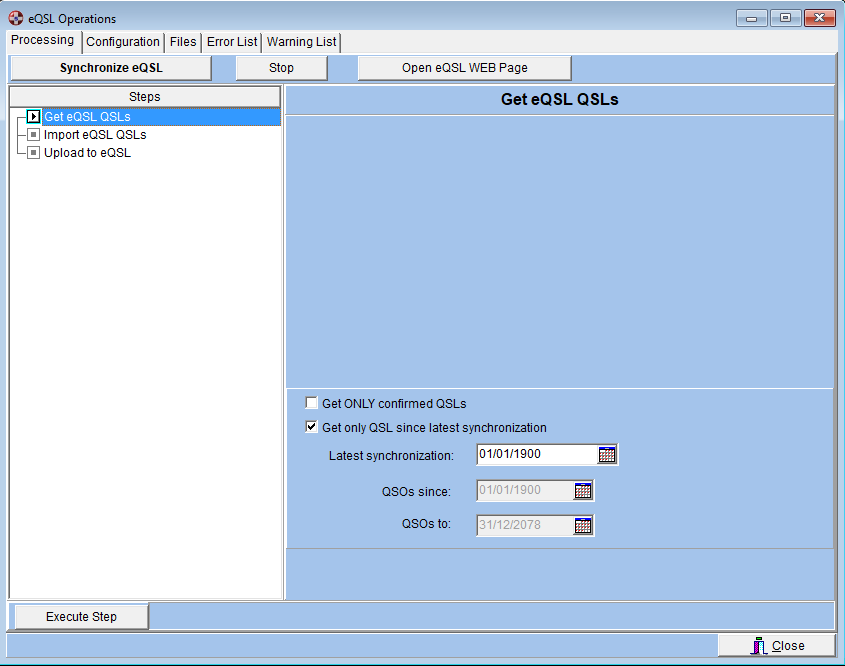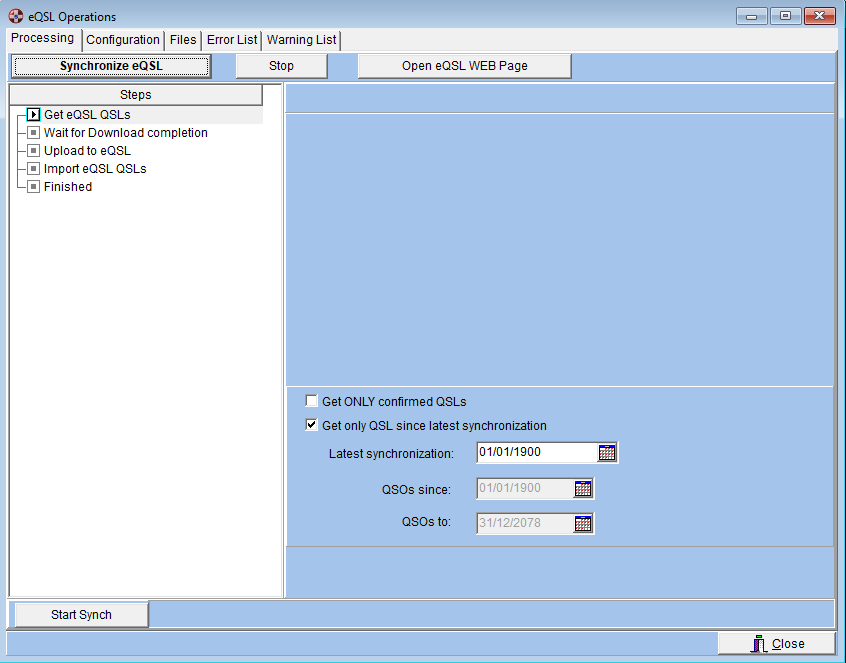
eQSL Support
IMPORTANT: eQSL synch requires SSL connections with TLS 1.2 which is only supported in Windows Vista or higher. If you have Windows XP this function will be disabled.
eQSL is a free online service for radio amateurs that lets you exchange electronic QSL cards with other amateurs that you have made contact with. Some amateurs collect paper QSL cards, but many prefer the immediacy of getting an electronic QSL card – as it's faster and cheaper than waiting for a paper card. SWISSLOG features fully integrated support for the eQSL, offering an exclusive feature not found in any other logging program: no matter how many callsigns and QTH you are using in your logbook! Swisslog will perform the synchronization in all your eQSL accounts and different QTH! Once you have configured Swisslog for eQSL, you can synchronize your Logbook with eQSL by just pressing two buttons.
Before you can use the eQSL function in Swisslog you must carry out a few initial setup procedures. Please see Preparation for eQSL for details.
Swisslog provides two modes for synchronization with eQSL:
The documentation is organized as follows:
The Automatic mode is generally the preferred mode of operation. However, because it is important to understand the action each step performs, the manual mode is explained first.
Note: This section provides a brief explanation of each function – for a more detailed explanation, please click on Detailed Description.
First, start the eQSL function from the main menu by selecting:
The dialog window shown below is displayed. Next, select the Processing page.

In the Steps window shown above, you will see the three most important steps in the eQSL process, these are explained below:
If you check the option Get ONLY confirmed QSLs, Swisslog will only download confirmed QSL. It's very important to know the difference between Confirmed and Not Confirmed:
- Confirmed means QSLs that eQSL has found a match (+- 1 hour) with any of your uploaded QSOs.
- Not confirmed means QSLs requested in the Inbox but eQSL has not found any match in your uploaded QSOs. You have to check these QSOs carefully in your log for any possible errors: maybe you did a type error and you need to correct something. Or maybe the QSO partner uploaded a QSO with a wrong band, mode, date, time or callsign, or simply is not in your log. In this case, you will have to review your Inbox/Archive in your eQSL account and reject the QSLs manually, indicating the reason.
By default, the Get only QSL since latest synchronization is checked (recommended). The first time you execute this step Swisslog will retrieve all QSLs. Swisslog saves the date and time after every complete synchronization (after a succesful QSL importation). The latest synchronization date/time is displayed in the Latest synchronization field. This option is very useful to download only new QSLs entered in eQSL system since the latest synchronization date, making the synchronization process faster.
If you uncheck the Get only QSL since latest synchronization option, ALL QSLs from Inbox/Archive will be downloaded (both confirmed and not confirmed). Except if you check the Get ONLY confirmed QSLs, that only confirmed QSL will be downloaded. QSOs since and QSOs to fields will be enabled. IMPORTANT: The selected date range is based on the QSO dates. eQSL only accepts a QSO date range from 01/01/1900 and 31/12/2078. Swisslog will correct the dates if you are trying to set a date out of this range.
You must be connected to the internet to perform this function. It is executed asynchronously, which means you can perform other non-eQSL functions during the download. You will see the number of QSLs downloaded (or the message: no new QSL) for every QTH.
Hint: This is the very first operation you should perform if you have previously uploaded QSO's to eQSL.
Although eQSL is now ADIF v3 compliant, according to my experience, and depending how the QSO partner has uploaded the QSO into eQSL, it may happen that the ADIF from eQSL contains a mode/submode or band which it's not ADIF v3 compliant. If Swisslog finds a mode/band not ADIF v3 compliant, a dialog window will appear and prompt you to select the right information, which will be stored in the mapping tables.
Hint: This is the second step you should perform after you have downloaded QSL's in step 1. This step will update the eQSL Status for the QSL's downloaded from eQSL and will prevent these QSO's from being selected for upload again.
IMPORTANT NOTE: If your log contains Local Time you must check Log contains Local Time! Swisslog then calculates the UTC based on the time difference defined in the corresponding My-QTH entry. This calculation does not take into account daylight saving time!
You must be connected to the internet to perform this function. This is a synchronous operation therefore, you can not perform any other Swisslog functions at the same time. Swisslog reads the response from eQSL for every QSO. If successful, Swisslog updates the eQSL Status to 'Uploaded'. Setting the status to 'Uploaded' assures that the QSO is not selected to be uploaded again.
You will see a progress bar indicating the total number of QSOs to be uploaded for every QTH and the current QSO number being uploaded. It may take a lot of time depending the number of QSOs to be uploaded. QSO rate per minute may vary depending your PC, your internet connection and the eQSL server workload. Estimated rate should be between 100-150 QSOs per minute. After finishing the upload step please check the Warnings List tab to see if there have been problems uploading some QSOs. If you have previously uploaded QSO to eQSL directly (without using Swisslog), in the first synchronization is normal you get many Duplicate warnings. Swisslog will update the eQSL status to "Uploaded" on these QSOs.
The Automatic Mode allows you to synchronize eQSL with just a few clicks with the mouse. SWISSLOG calculates and performs all of the necessary steps – this is the preferred mode of operation.
See the section Detail Description for more details.
First, start the eQSL function from the main menu by selecting:
The steps needed to synchronize your Log with eQSL are automatically calculated. You must be connected to the Internet otherwise SWISSLOG does not insert the upload and download steps.
You will note, that one 'Wait' steps are inserted. The reason for this is, the Download process is performed asynchronously. Download can overlap with functions performed locally on your PC. All other steps are exactly as explained in the Manual Mode section.
To change back the the Manual Mode or to stop the Automatic process, press the Stop button.

When the eQSL synchronization is finished, check the Error List and Warning List tabs (you can save the list in a file).
Copyright © 2004 SWISSLOG
Last modified:
07 ene. 2019